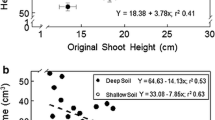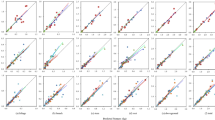Abstract
• Context
While past studies on epicormics in oak (Quercus sp.) have focused on the effect of thinning on epicormic shoots emergence, the consequences of this emergence on the epicormic ontogeny and future wood quality have rarely been asked.
• Aims
This paper aims to quantifying the relationship between past emergence and current composition of epicormics.
• Methods
Three thinning experiments with Quercus petraea (Matt.) Liebl. or Quercus robur L. were investigated. Epicormic shoots were regularly tallied and epicormic composition recorded recently. Some logs were scanned using X-ray computed tomography (CT).
• Results
Past tallies on both species were mainly and positively related to the current frequency of bud clusters and burls. This was due to the production of buds by epicormic shoots for only certain trees, as evidenced by CT, and mainly to correlated numbers of current epicormic shoots, bud clusters and burls, all originating from a past common set of buds and bud clusters.
• Conclusion
The important tree effect on both species suggests that oak silviculture can be optimized by the early selection of crop trees with few epicormics and/or eventually a first and heavy thinning that helps in spotting remaining individuals being prone to the development of multiple epicormics.










Similar content being viewed by others
References
Barthélémy D, Caraglio Y (1997) Plant architecture: a dynamic, multilevel and comprehensive approach to plant form, structure and ontogeny. Ann Bot 99:375–407
Bell AD (1991) Plant form. An illustrated guide to flowering plant morphology. Oxford University Press, Oxford, p 341
DREAL Champagne-Ardenne (2010) Bulletin de situation hydrologique. Région Champagne-Ardenne. Bilan du mois de décembre 2010. p22
Colin F, Robert N, Druelle JL, Fontaine F (2008) Initial spacing has little influence on transient epicormic shoots in a 20-year-old sessile oak plantation. Ann For Sci 65:508–517
Colin F, Mechergui R, Dhôte JF, Fontaine F (2010a) Epicormic ontogeny on Quercus petraea trunks and thinning effects quantified with the epicormic composition. Ann For Sci 67:813
Colin F, Ducousso A, Fontaine F (2010b) Epicormics in 13-year-old Quercus petraea: small effect of provenance and large influence of branches and growth unit limits. Ann For Sci 67:312–323
Colin F, Mothe F, Freyburger C, Morisset JB, Leban JM, Fontaine F (2010c) Tracking rameal traces in sessile oak trunks with X-ray computer tomography: biological bases preliminary results and perspectives. Trees. Struct Funct 24:953–967
Courraud R (1987) Les gourmands sur les chênes “rouvre”et “pédonculé”. Forêt-Entrep 45:20–49
Dhôte JF, Hatsch E, Rittié D (2000) Forme de la tige, tarifs de cubage et ventilation de la production en volume chez le Chêne sessile. Ann For Sci 57:121–142
Fontaine F. (1999) Les bourgeons épicormiques chez le chêne sessile (Quercus petraea): établissement des bases en vue de l’évaluation dynamique d’un potentiel épicormique. Thèse de doctorat, Université de Reims Champagne-Ardenne, volume I, 101 p, volume II, 94 p
Fontaine F, Druelle JL, Clément C, Burrus M, Audran JC (1998) Ontogeny of proventitious epicormic buds in Quercus petraea. I. In the 5 years following initiation. Tree Struct Funct 13:54–62
Fontaine F, Kiefer E, Clément C, Burrus M, Druelle JL (1999) Ontogeny of proventitious epicormic buds in Quercus petraea. II. From 6 to 40 years of the tree’s life. Tree Struct Funct 14:83–90
Fontaine F, Colin F, Jarret P, Druelle JL (2001) Evolution of the epicormic potential on 17-year-old Quercus petraea trees: first results. Ann For Sci 58:583–592
Fontaine F, Mothe F, Colin F, Duplat P (2004) Structural relationships between the epicormic formations on trunk surface and defects induced in the wood of Quercus petraea. Tree Struct Funct 18:295–306
Fournier M, Churin JL, Fontaine F, Colin F, Fontaine F (2003) Bilan croissance-qualité d’un essai de mycorhization contrôlée sur chêne pédonculé, 16 ans après plantation. Rev For Fr LV 1:25–33
Hahne B (1926) The origin of secondary dormant buds in deciduous fruit trees. Univ Calif Publ Bot 13:125–126
Hasenauer H, Monserud RA (1996) A crown ratio model for Austrian forests. Forest Ecol Manag 84:49–60
Jarret P (2004) Chênaie atlantique: guide des sylvicultures. ONF (ed). Lavoisier, Paris, 335p
Lemaire J (1992) Sylviculture du chêne pédonculé de qualité: intensités d’éclaircie en futaie régulière. Forêt-Entrepr 146:53–59
McCullagh P, Nelder JA (1989) Generalized linear models, 2nd edn. Champman & Hall, London
Morisset JB, Mothe F, Bock J, Bréda N, Colin F (2011) Epicormic ontogeny in Quercus petraea Liebl. constraints the highly plausible control of epicormic sprouting by water and carbohydrates. Ann Bot (in press)
Nutto L (1999) Neue Perspectiven für die Begründung und Pflege von jungen Eichenbeständen. Ergebnisse einer Untersuchung zur Kronenentwicklung, Astreinigung und Dickenwachstum junger Stiel- und Traubeneichen in Europa (Quercus robur L. und Quercus petraea (Matt.) Liebl.). Schriftenreihe Freiburger Forstliche Forschung; Bd. 5. Forstwissenschaftliche Fakultät der Universität Freiburg und Forstliche Versuchs- und Forschungsanstalt Baden-Württemberg. 190 S
Pardé (1978) Normes de sylviculture pour les forêts de chêne rouvre. Revue Forestière Française 30:11–17
Rasband, W.S. (1997–2009) ImageJ. U.S. National Institutes of Health, Bethesda, Maryland, USA. Available at http://rsb.info.nih.gov/ij/.
Sardin T (2008) Chênaies continentales: guide des sylvicultures. Office National des forêts. 455p
Spiecker H (1991) Zur Steuerung des Dickenwachstums und der Astreinigung von Trauben-und Stieleichen (Quercus petraea (Matt.) Liebl. und Quercus robur L.). Schriftenreihe der Landesforstverwaltung, Band 72, p. 150
Acknowledgements
We wish to give our warm thanks to Frédérique Vautier who was responsible for the management of the LO experiment; Yves Bresson and François Conrard who managed and measured the three ONF experiments regularly; and Jean-Louis Druelle, professor at Reims University, who helped to describe the epicormic composition in 2007 and 2008.
Funding
The French National Forest Service (ONF) supported this study financially through the ModelFor contract together with INRA who provided JB Morisset’s Ph.D. grant.
Author information
Authors and Affiliations
Corresponding author
Additional information
Handling Editor: Barry Alan Gardiner
Contribution of the co-authors
Francis Colin, Didier François: field measurements. Jean-Baptiste Morisset, Frédéric Mothe: interpretation of scan images. Jean-Baptiste Morisset, Francis Colin: running the data analysis. Jean-Baptiste Morisset, Francis Colin, Frédéric Mothe: writing the paper. Francis Colin, Bruno Chopard: supervision of the work and coordinating the project.
Rights and permissions
About this article
Cite this article
Morisset, JB., Mothe, F., Chopard, B. et al. Does past emergence of epicormic shoots control current composition of epicormic types?. Annals of Forest Science 69, 139–152 (2012). https://doi.org/10.1007/s13595-011-0148-1
Received:
Accepted:
Published:
Issue Date:
DOI: https://doi.org/10.1007/s13595-011-0148-1




